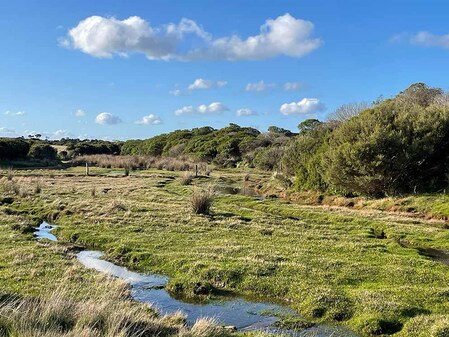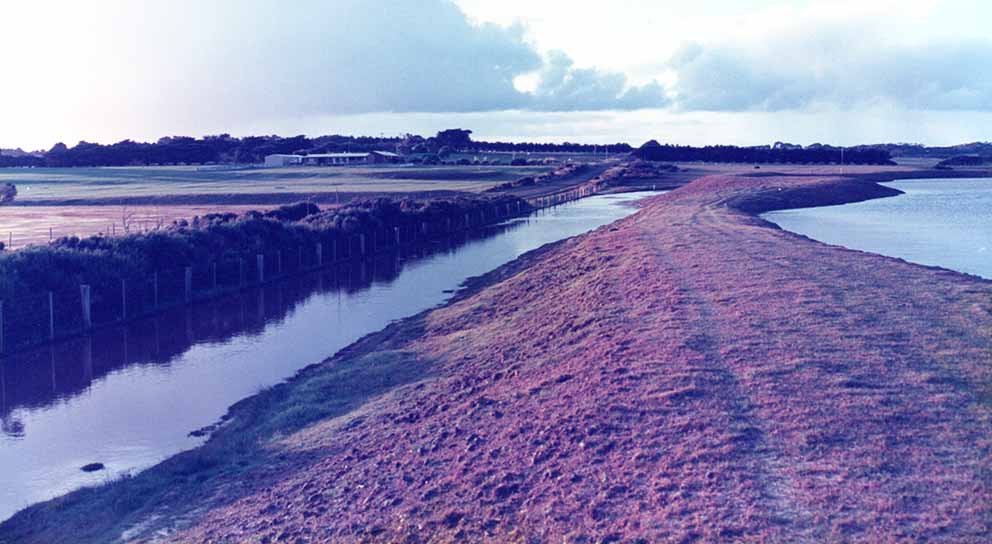 It took almost 40 years to attain a sparse vegetation cover around the
It took almost 40 years to attain a sparse vegetation cover around the man-made and very saline Kitty Miller Wetlands. Photos: Linda Cuttriss
AT THE far end of Phillip Island, on private land not far from the Penguin Parade, the Kitty Miller Wetlands stretch across the landscape and shimmer in the afternoon sun. This morning as I drove past the wetlands down Kitty Millers Road, several days of rain have swelled the waterway that flows downstream to Swan Lake. Water flows over soft grasses. Black swans, purple swamphens and Cape Barren geese preen and feed in the morning sunshine. A white-faced heron stalks prey in shallow pools. Swallows swoop and dive and a willy wagtail flits across the ground. Further along, a wallaby bounds casually across the road.
The Kitty Miller Wetlands are currently part of a planning application to develop an ‘eco resort’ for 96 people consisting of a large two-storey Gateway House with private restaurant and information centre, 15 x one, two, three and four-bedroom units and 14 x one-bedroom ‘eco-tents’ on boardwalks extending into the wetlands. The proposal includes bulk earthworks to remove some of the existing wetland embankments to create larger waterbodies. Construction of the resort buildings and removal of the current embankments will result in removal of 3.6 hectares of vegetation, almost twice the area of the two-hectare open paddock in the NW corner of the property.
The history of the Kitty Miller Wetlands raises serious concerns about potential impacts on the environment and landscape. While the proposal includes a “significant regeneration strategy” there are questions about its viability. Major earthworks to remove some of the current wetland embankments could leave a barren scar across the landscape and there is a risk that highly saline water could be inadvertently released downstream to Swan Lake.
In 1991, I undertook a study of the Kitty Miller Wetlands as part of my Master of Environmental Studies degree. I documented the background of the wetlands, the environmental conditions at the time and the concerns of the landowner and a senior biologist at the Penguin Reserve in the event of any breach of the embankment walls.
Swan Lake Drain, the waterway that flows from the catchment north of Back Beach Road downstream to Swan Lake, was a severely eroded channel two to three metres deep. Salinity of the lakes was measured in April, August and October. All the lakes were saline and in April the central lake was one and a half times the salinity of seawater.
At the time, biologist Rosalind Jessop at the Penguin Reserve (now Phillip Island Nature Parks) held concerns about erosion causing a breach of the embankments and releasing saline water downstream. She said any increase of salt into Swan Lake would destroy the existing ecosystem. There were also concerns of flooding through the lower penguin burrows.
Swan Lake is a brackish/freshwater lake with water levels that fluctuate markedly according to the season and rainfall levels. Erosion of silt, increased salinity or reduced water flows into the lake could have a detrimental effect on this important ecosystem that supports around 100 species of birdlife, the rare growling grass frog and a rare Galaxias fish species.
Throughout the 1990s, a major Landcare revegetation project took place to rehabilitate the wetland embankments. Mass plantings of local indigenous plants initially failed in the degraded saline soils. Volunteers returned time and again until, after about 10 years, plants began to establish. It took another 10 years for the embankments to attain a sparse but stable vegetation cover.
The 1990s Landcare project preceded the current “abundance” of wildlife on Phillip Island which now makes revegetation projects extremely challenging. Swamp wallabies, Cape Barren geese and purple swamphens browse on plant seedlings and root up young plants and are common around the wetlands, across nearby farmland and at Swan Lake.
The environment at Kitty Miller Wetlands, including Swan Lake Drain, has now stabilised and provides habitat and breeding areas for a range of wildlife and birdlife including eastern barred bandicoots that, prior to the recent recovery program by Phillip Island Nature Parks, were listed as “extinct in the wild” in Victoria. The proposed “eco resort” would destroy habitat that took decades to develop and would displace the wildlife that have made it their home.
The history of the Kitty Miller Wetlands should be a cautionary tale for the proposed tourism development. A failed regeneration strategy would be an eyesore for visitors travelling to the Penguin Parade and could leave a scar across the view of Phillip Island’s state significant southern coastline for many years to come.
